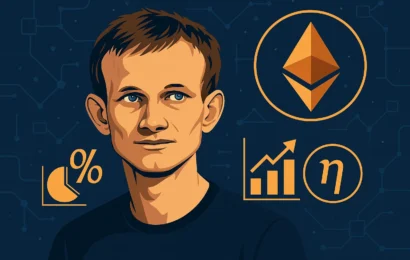
“The new local-first approach by Vitalik Buterin could reduce the need for 1.3TB of local storage by syncing only the data relevant to the user.”
Key Highlights:
- The proposal eliminates the need to store the entire blockchain history.
- Nodes will follow only user-relevant data and verify the rest on demand.
- The approach aligns with the upcoming Pectra upgrade and Ethereum’s vision of running on consumer devices.
A New Approach to Light Nodes
Ethereum co-founder Vitalik Buterin is proposing a fundamental shift in how users sync their nodes—with a focus on local use and minimal hardware requirements.
According to Buterin, running a full node allows users to read the blockchain in a trusted, censorship-resistant, and privacy-preserving way. The problem? A full node requires over 1.3 terabytes of data, which is too much for the average computer.
“Despite many optimizations, the cost of storing and maintaining a full node remains too high.”
Buterin wrote in the Ethereum Research blog.
The New Model: Only What You Need
The proposal is simple: nodes will store only what they need, while older data will be distributed across many nodes in the network. This effectively creates a “blockchain library,” from which nodes can “borrow” data when needed.
“There’s no need to keep all the books in your branch if you can borrow them from others.”
explains analyst Ryan Yoon of Tiger Research.
Part of Ethereum’s Long-Term Vision
Buterin has long pushed for a future where anyone can run a node on a regular laptop or even a phone. The new “local-first” approach is a step in that direction.
This aligns with Ethereum’s overall roadmap, where the Pectra upgrade will play a key role. The goal is to eliminate dependence on a few large infrastructure providers who could be pressured politically or economically to restrict access.
“Ethereum, structured this way, risks becoming a system vulnerable to censorship,” Buterin warns.
Experts Respond
“The proposal is like a breath of fresh air,” says Michael Cameron, co-founder of Vanilla Finance. He notes that even with new Ethereum tech offering trust and privacy, too much reliance on a few participants creates risks of centralization.
Yoon adds that geographic distribution of nodes could improve network resilience but stresses the need for in-depth analysis of how to apply such a model.
Conclusion:
Buterin’s proposal could significantly change how everyday users interact with Ethereum—from infrastructure accessible only to professionals to a decentralized network accessible to all.
The road won’t be easy, but as Cameron puts it:
“This is a battle worth fighting.”
Frequently Asked Questions
Find answers to the most common questions below.
It's a new synchronization model that allows Ethereum nodes to store only necessary user data, significantly reducing storage requirements.
It enables more users to run Ethereum nodes on standard devices like laptops or phones, enhancing decentralization and accessibility.
No, core security remains intact as smart contracts and consensus stay unchanged. Data is borrowed securely from distributed peers only when needed.
This article is for general informational purposes only and is not intended to be, and should not be construed as, legal or investment advice. Crypto-assets are highly volatile, so only invest funds you are willing to lose and use your own research and risk management.




